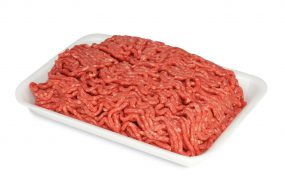2018 Salmonella Infections Linked to Ground Beef
Final Update

Posted March 22, 2019 at 3:15 PM ET
This outbreak appears to be over. Consumers and restaurants should always handle and cook ground beef safely to help prevent foodborne illness.
CDC, public health and regulatory officials in several states, and the U.S. Department of Agriculture’s Food Safety and Inspection Service investigated a multistate outbreak of Salmonella Newport infections linked to ground beef produced by JBS Tolleson, Inc.
- Reported Cases: 403
- States: 30
- Hospitalizations: 117
- Deaths: 0
- Recall: Yes
- Although the outbreak investigation is over, contaminated beef could still be in freezers. Check your freezer for beef recalled by JBS Tolleson, Inc., of Tolleson, Arizona, and do not eat, serve, or sell it.
- Recalled beef products were produced and packaged from July 26, 2018, to September 7, 2018 and were shipped to retailers nationwide under many brand names.
- The company recalled 6.9 million pounds of beef products on October 4, 2018, and then recalled an additional 5.2 million pounds of beef products on December 4, 2018.
- When you check your freezer for recalled beef, look for beef labeled with the establishment number “EST. 267.” This is usually found inside the USDA mark of inspection, but can be elsewhere on the package.
- More than 100 retailers, including chain retail locations and local stores, sold the recalled beef. Visit the USDA-FSIS website for a list of stores and states where the recalled beef products were sold [PDF – 322 KB]. Stores are listed by state, in alphabetical order.
- Return recalled beef to the store or throw it away.
- Consumers with questions about the recall can call the JBS USA Consumer Hotline at (800) 727-2333.
- Contact a healthcare provider if you think you got sick from eating recalled ground beef.
- Restaurants and retailers should check food storage and freezers for recalled beef products and should not serve or sell them.
- If possible, retailers who received recalled beef products should contact their customers to alert them to the recall.
- Consumers and restaurants should always handle and cook ground beef safely to help prevent foodborne illness. It is important to cook ground beef thoroughly to an internal temperature of 160°F.
- As of March 22, 2019, this outbreak appears to be over.
- A total of 403 people infected with the outbreak strain of Salmonella Newport were reported from 30 states.
- Illnesses started on dates ranging from August 5, 2018 to February 8, 2019.
- 117 people were hospitalized. No deaths were reported.
- Epidemiologic, laboratory, and traceback evidence indicated that ground beef produced by JBS Tolleson, Inc. was a likely source of this outbreak.
- On October 4, 2018, JBS Tolleson, Inc. recalled approximately 6.9 million pounds of beef products that may be contaminated with Salmonella Newport bacteria. On December 4, 2018, JBS Tolleson, Inc. recalled an additional 5.2 million pounds of beef products.
- Don’t eat raw or undercooked ground beef.
- Cook ground beef hamburgers and mixtures such as meatloaf to 160°F internal temperature. Use a food thermometer to make sure the meat has reached a safe internal temperature. You can’t tell whether meat is safely cooked by looking at it.
- For hamburgers, insert thermometer through the side of the patty until it reaches the middle.
- Place the thermometer in the thickest part of the meat for other items.
- Ask that ground beef hamburgers and mixtures be cooked to 160°F internal temperature when ordering at a restaurant.
- Wash hands and items that came into contact with raw ground beef—including countertops, utensils, dishes, and cutting boards—with soap and water.
- Most people infected with Salmonella develop diarrhea, fever, and stomach cramps 12 to 72 hours after being exposed to the bacteria.
- The illness usually lasts 4 to 7 days, and most people recover without treatment.
- In some people, the diarrhea may be so severe that the patient needs to be hospitalized. Salmonella infection may spread from the intestines to the bloodstream and then to other places in the body.
- Children younger than 5 years, adults older than 65 years, and people with weakened immune systems are more likely to have a severe illness.
March 22, 2019
CDC, public health and regulatory officials in several states, and the U.S. Department of Agriculture’s Food Safety and Inspection Service (USDA-FSIS) investigated a multistate outbreak of Salmonella Newport infections.
Public health investigators used the PulseNet system to identify illnesses that may have been part of this outbreak. PulseNet is the national subtyping network of public health and food regulatory agency laboratories coordinated by CDC. DNA fingerprinting was performed on Salmonella bacteria isolated from ill people by using techniques called pulsed-field gel electrophoresis (PFGE) and whole genome sequencing (WGS). CDC PulseNet manages a national database of these DNA fingerprints to identify possible outbreaks. WGS gives a more detailed DNA fingerprint than PFGE. WGS performed on bacteria isolated from ill people showed that they were closely relatedly genetically. This means that people in this outbreak were more likely to share a common source of infection.
As of March 21, 2019, 403 people infected with the outbreak strain of Salmonella Newport were reported from 30 states. A list of the states and the number of cases in each can be found on the Map of Reported Cases page.
Illnesses started on dates ranging from August 5, 2018 to February 8, 2019. Ill people ranged in age from less than one year to 99, with a median age of 42. Forty-nine percent were male. Of 340 people with information available, 117 (34%) were hospitalized. No deaths were reported.
Whole genome sequencing analysis did not identify predicted antibiotic resistance in 403 Salmonella bacteria isolates from 398 ill people and five food samples. Testing of 17 outbreak isolates using standard antibiotic susceptibility testing by CDC’s National Antimicrobial Resistance Monitoring System (NARMS) laboratory confirmed these results.
Investigation of the Outbreak
State and local health departments asked ill people questions about the foods they ate and other exposures in the week before they became ill. Of 277 people interviewed, 237 (86%) reported eating ground beef at home. This percentage is significantly higher than results from a survey [PDF – 787 KB] of healthy people in which 40% of respondents reported eating any ground beef at home in the week before they were interviewed. Also, several unrelated ill people ate ground beef at the same events or purchased ground beef at the same grocery store chains, suggesting that the contaminated food item was served or sold at those locations.
Officials in Arizona and Nevada collected opened and unopened packages of ground beef from ill people’s homes. Officials also collected unopened packages of ground beef from retail locations. The outbreak strain of Salmonella Newport was identified in the ground beef. Whole genome sequencing showed that the Salmonella identified in the ground beef was closely related genetically to the Salmonella in samples from ill people. USDA-FSIS and state partners traced the source of the ground beef eaten by ill people in this outbreak to JBS Tolleson, Inc.
On October 4, 2018, JBS Tolleson, Inc. recalled approximately 6.5 million pounds of beef products that may be contaminated with Salmonella Newport. On December 4, 2018, JBS Tolleson, Inc. recalled an additional 5.2 million pounds of beef products.
As of March 22, 2019, this outbreak appears to be over.




